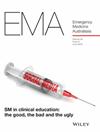Evaluating the Introduction of Humidified High-Flow Nasal Cannula Therapy Into an Australian Aeromedical Service Within a Paediatric Population: A Retrospective Cohort Study
Abstract
Introduction
Humidified high flow (HHF) oxygen is increasingly used to treat acute respiratory illnesses in children; however, use during aeromedical transfer is not well described.
Methods
This was a retrospective cohort study. Children who were transferred from rural locations and were initiated on HHF prior to transfer between 1 January 2015 and 31 December 2018 were identified from the Royal Flying Doctors Service database. Clinical variables prior to transfer, during flight and after transfer were collected from medical records and flight records. Variables were compared between those who continued and did not receive HHF inflight with Wilcoxon rank sum test and Fisher's exact test, with a p-value less than 0.05 indicating statistical significance.
Results
A total of 61 cases were included, 29 did not receive HHF inflight, 32 continued HHF inflight. The median age of participants was 8 months (IQR 4). The most common reasons for transfer were bronchiolitis (55%) and pneumonia (33%). Children who had a higher respiratory rate (p = 0.021) or had severe work of breathing were more likely to continue HHF inflight (p = 0.012). Those who continued HHF inflight were more likely to continue HHF therapy in the tertiary hospital (p ≤ 0.001). There was no difference in hospital length of stay between the two groups and no significant complications associated with HHF use during flight.
Conclusion
Our study adds to a growing body of literature that the use of HHF during aeromedical transfer is safe and does not lead to increased length of hospital stay.

 求助内容:
求助内容: 应助结果提醒方式:
应助结果提醒方式:


